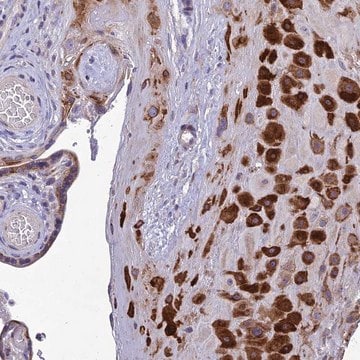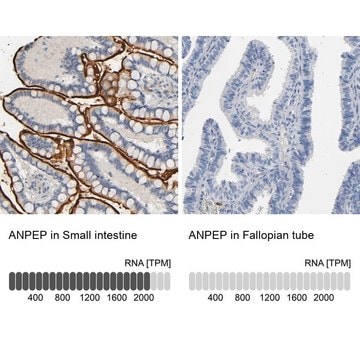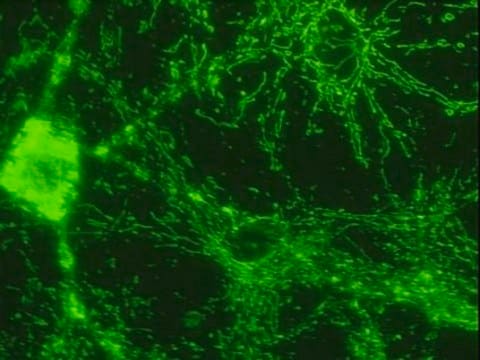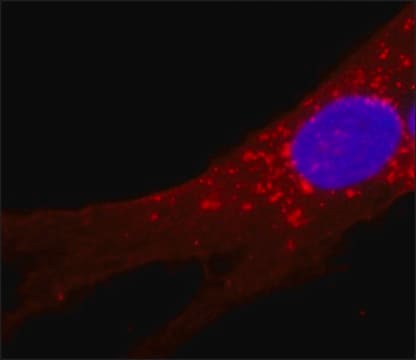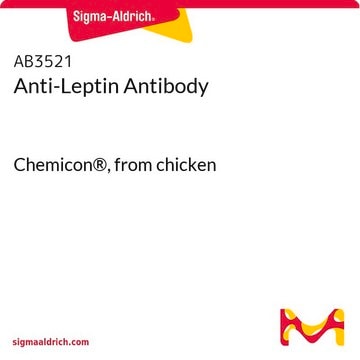General description
Adiponectin receptor protein 2 (UniProt Q86V24; also known as Progestin and adipoQ receptor family member II) is encoded by the ADIPOR2 (also known as PAQR2) gene (Gene ID 79602) in human. Adiponectin receptor protein 1 & 2 (AdipoR1 & AdipoR2) are receptors for adiponectin, a well knonwn anti-inflammatory adipokine highly abundant in serum. Both AdipoR1 and AdipoR2 are reported to be ubiquitously expressed with the highest expression in skeletal muscle and liver, respectively. Circulating adiponectin levels are reduced in obesity and type II diabetes, whereas weight loss elevates serum adiponectin. Adiponectin deficiency in mice is reported to exacerbate metabolic dysfunction by diet-induced obesity in some studies, while adiponectin overexpression alleviates metabolic dysfunction independent of weight loss in both genetic and diet-induced animal models of obesity. Adipor1-knockout (KO) results in increased adiposity and decreased glucose clearance in mice, whereas Adipor2-KO mice are lean and displayed improved glucose clearance. In addition to its metabolic role, adiponectin deficiency is associated with various clinical cardiovascular disorders including myocardial infarction, peripheral artery disease, and endothelial dysfunction. In a study of murine hind limb ischemia model, blood flow recovery after chronic hind limb ischemic surgery is similar among wild-type and AdipoR1-KO mice, while revascularization in AdipoR2-KO mice is severely attenuated. Human AdipoR2 is a 7-transmembrane (a.a. 148-168, 182-202, 214-234, 246-266, 274-294, 310-330, 349-369) protein with the opposite topology of G protein-coupled receptors (GPCRs), having its N-terminal end at the cytoplasmic side (a.a. 1-147) and C-terminal end at the extracellular side (a.a. 370-386). Unlike GPCRs also, adipoR1 & AdipoR2 transmembrane helices are not kinked or tilted relative to the plane of the membrane.
Specificity
Clone 4D3.2 targets an epitope within the N-terminal cytoplasmic domain.
Immunogen
Epitope: N-terminal cytoplasmic domain.
GST-tagged recombinant human AdipoR2 N-terminal fragment.
Application
Immunohistochemistry Analysis: A 1:250 dilution from a representative lot detected AdipoR2 in human prostate cancer, as well as normal rat heart and human cerebral cortex tissue sections.
Research Category
Signaling
Research Sub Category
Lipid Metabolism & Weight Regulation
This Anti-AdipoR2 Antibody, clone 4D3.2 is validated for use in Western Blotting, Immunohistochemistry (Paraffin) for the detection of AdipoR2.
Quality
Evaluated by Western Blotting of GST-tagged human AdipoR2 N-terminal fragment.
Western Blotting Analysis: A 1:1000 dilution of this antibody detected 50 ng of GST-tagged recombinant human AdipoR2 N-terminal fragment.
Target description
43.88 kDa calculated.
Physical form
Format: Purified
Protein G purified.
Purified mouse monoclonal IgG1κ antibody in buffer containing 0.1 M Tris-Glycine (pH 7.4), 150 mM NaCl with 0.05% sodium azide.
Storage and Stability
Stable for 1 year at 2-8°C from date of receipt.
Other Notes
Concentration: Please refer to lot specific datasheet.
Disclaimer
Unless otherwise stated in our catalog or other company documentation accompanying the product(s), our products are intended for research use only and are not to be used for any other purpose, which includes but is not limited to, unauthorized commercial uses, in vitro diagnostic uses, ex vivo or in vivo therapeutic uses or any type of consumption or application to humans or animals.
